Signs your Teen is Stressed Out
Does your teen struggle? Discover the early warning signs of teen stress and learn an action plan to help your teens cope with school, SATs, and...
5 tips to digital detox for teens. This guide will help parents set healthy boundaries and learn about new ways to boost self-esteem in your teen.
We've all heard frightening stories of the long term negative impacts resulting from teens spending excessive time on their phones and social media. Reports of teens bullying peers over social media, crumbling self esteem and shame about body image, and even horrific reports of teen on teen violence have become sadly and shockingly, commonplace. For parents concerned about these potentially harmful effects on their children is a real issue - and not an easy one to navigate. Social media is the way teens connect with each other, for better and worse! The issue of how much phone use is healthy is being debated by experts - and parents everywhere are looking for guidance on how to create a realistic, healthy balance.
Let's dive in and look at the reality: how much do teenagers spend on social media? A study by Common Sense shows that the average teen uses about 9 hours of media per day and tweens are engaged for 6 hours a day. That's a lot. A recent study shows that children aged 4-15 average 90 minutes a day on TikTok alone! The most popular social media outlet for teens is still YouTube, with 85% of teens using it, compared with 70% using TikTok and SnapChat.
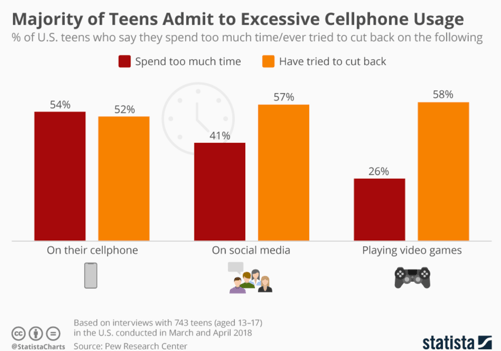
A 2019 study shows that more than three hours of social media a day has a negative impact on the mental health of teenagers. Just a cursory review of the metrics above means our children are at risk.
Meanwhile, studies over the years have consistently shown that anxiety and depression are most commonly the mental health conditions connected with teens spending too much time on their smart phones.
Additionally, night time phone use is directly correlated with reduced and poorer quality of sleep among teens. This data is concerning given that teenagers do not get the recommended 10 hours of sleep a night. Meanwhile, sleep deprivation in teens is associated with diminished school performance and less than optimal mental health.
One way to curb the negative impacts of over engagement on social media and phone use is to limit the amount of screen time. Given how challenging it is to constantly monitor a child's use of social media, one solution is to try a family or teen "digital detox." Research with college students found that their school productivity and sleep improved, and their anxiety was noticeably lower after a two-week digital detox.
A digital detox means refraining from the use of electronics, mainly smart phones, tablets and computers, for a set period of time, with the goal to break the habit of overusing electronic devices. There is also a "social media detox" which is the same idea but with the specific intention of not using social media platforms. With a social media detox the use of devices is acceptable for things like email and work purposes. Overall, general expectation of participants is that when people consciously refrain from using devices and social media they are helping improve their quality of life - specifically in the areas of mental health, sleep and productivity. People who do a digital detox also discover they can free up time for generally more healthy activities like spending time in nature, mindfulness practices and quality time with friends and family.
The most common ways people undertake a digital detox is to set boundaries around the use of their devices. Simple, practical boundaries could include:
First - and admittedly trickiest step, is to start a conversation with your teenager about what they experience as the positives and negatives of using their phone and social media. Some families start this conversation with watching a documentary, such as Social Dilemma or read an article by a teen influencer, such as The Reason For Digital Detox of Influencers 2.0, to begin a shared, positive dialogue.
Come up with a plan together for how your teen could experiment with a digital detox, so they can take ownership and see the positive impact they helped create by spending less time on their phones. Make the experience a 'win' even if the teen doesn't follow the plan perfectly.
Below are five tips for creating a detox from social media and devices. And remember - the goal is to create a more healthy, emotional environment. So make sure you're not framing this a retributive, or punishing type of mandate.
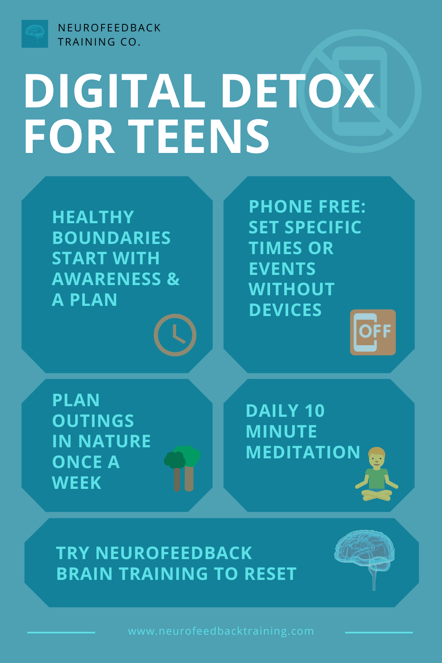
Instituting healthy boundaries around screen time are helpful and typically best achieved with teenagers by starting with an open discussion around how they got to a place of "too much screen time". Start with a general awareness and an attitude of open exploration - without blame of - "how did we get here?".
In starting a conversation around why boundaries around screen time are helpful, parents can help their children by taking responsibility for the problem. Acknowledging that children's behavior is ultimately the parents' responsibility will help the children feel secure and open. It communicates that the parent does not see the teenager as the "problem". The key is always acknowledging you are engaging this practice as a family.
Parents can also acknowledge their own lack of boundaries around their phone use. By reflecting on the overuse and lack of intention behind screen time, parents help children see they aren't alone in making decisions without a well thought out plan firmly in place. As an example, a parent could say, "I see that I've modeled how easy and repetitive it is to just mindlessly grab the phone and start scrolling, without being aware of whether it was a good activity to engage in."
It is never too late to think about how you want your teen (or yourself) to use his or her cellphone, tablet, or computer. Transparent and honest communication about what is not healthy about devices and social media coupled with how to experiment with boundaries around use, will lead to more cooperation from your teenager.
Children benefit when parents model the behavior they're offering as "healthy", at home. It wouldn't make sense to lecture your children/teen on the importance of "healthy eating", while you munch down a Big Mac. Rules and expectations in each household will be different, but the key is to think about what works best for you, your kids and your family - and then take it on, as a family.
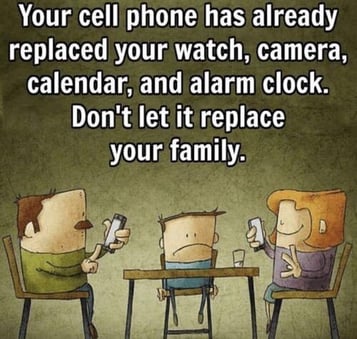
What would it be like to have a dinner with no phones? An evening that's phone and/or TV free? What about a weekend with minimal technology? Taking breaks from our cellphones and screens, whether it's one night or a whole vacation, allow for more time together and more human, family-based connection.
There are great resources available with tips for how to take a digital detox and how to talk to your kids about screen time. Check out: Screenwise Helping Kids Thrive (and survive) in their Digital World by Devorah Heitner.
Studies show that teens using their phones for shorter periods of time more frequently, creates better outcomes and leads to longer term beneficial habits for teens. An example would be a two-hour period a day when the phones are placed in a secure place, whether that's on top of the fridge or even a lock box that has a digital timer.
Do they work? Many people find using a detox app a helpful way to curb their social media or overall phone use. There are many different products (most of them free) to help limit your use. Some help build awareness by tracking how much time you spend on different apps and giving you data, while others, such as AppDetox make it so you can't open certain app for periods of time. The latter are helpful for parents who don't want to be constantly monitoring whether their teenager is complying with the detox plan.
Parents often ask how long a digital detox should be for a teenager? The answer depends on your teenager and the agreed upon goals. For some families, they try to start with a specified day a week or even a month dedicated to digital detox (again, with agreed upon boundaries in place). During that time, no devices are used - this is a way to both take a break from devices and social media but also to intentionally create room for other activities including family time, into everyone's busy schedules. Scheduling a set block of time that everyone adheres to is often an easier way to successfully integrate a digital detox. Devices are put away or left at home for the entire day, rather than for shorter periods. The more times transitioning between using and not using a device, the harder it is and also the more likely the device will not be surrendered or stopped.
If you plan to create digital detox times, whether it's a for a weekend, or including it a regular part of the family schedule, make sure to include some fun reward. Some people make it a "challenge" to acknowledge that it is hard to give up their phone and include a clear indicator when there has been success, with some reward at the end.
Remember that studies show "Likes" in social media increase dopamine, our happy brain hormone. So it's helpful to replace that 'hit' with something else that's experienced as a reward. Last year the company reviews.com offered participants a $2400 cash reward if they were able to stay off devices for 24 hours. That might be an extreme, but the offer communicates both that staying off devices are difficult and having a reward at the end helps!
 It's not enough to just limit the use of social media in our teens - we also want to add in health-promoting activities to replace the time spent on phones. Spending time in nature has been shown to improve mental health and decrease stress.
It's not enough to just limit the use of social media in our teens - we also want to add in health-promoting activities to replace the time spent on phones. Spending time in nature has been shown to improve mental health and decrease stress.
There are many ways to engage in nature from going to the park for a picnic dinner or a game of frisbee, to hanging out in the backyard reading a book, organized sports, and weekend hikes in a national forest. It may take some effort at first if your family or teenager is not used to being in nature. I encourage you to make the first adventures easy for the teen to say yes to, whether it's brining a friend, making it shorter, or even ending with a meal they would enjoy.
Besides the health benefits of being in nature, there's also the secondary benefit of getting exercise. Studies have shown that cardio workouts, such as a hike, bike ride or run, have the same benefits for mood as pharmaceutical interventions.
Spending time in nature is also simple good for you; it is rejuvenating and uplifting. If you'd like to get inspired about taking your child into nature I encourage you to check out one of Richard Luv's many books, such as Last Child In the Woods.
“If getting our kids out into nature is a search for perfection, or is one more chore, then the belief in perfection and the chore defeats the joy. It's a good thing to learn more about nature in order to share this knowledge with children; it's even better if the adult and child learn about nature together. And it's a lot more fun.”
― Richard Louv, Last Child in the Woods: Saving Our Children from Nature-Deficit Disorder
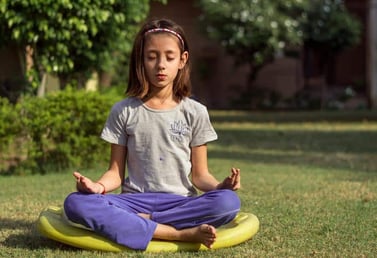
When coming up with replacement activities for your teen, starting a short mindfulness meditation routine can be very beneficial. The health benefits of meditation include: greater calm and focus, better awareness, greater self-esteem and a more realistic self-image.
These days, mindfulness meditation comes in many forms. For teens using an app such as Calm they can choose a guided meditation that's appealing and helpful, such as a body scan or meditation for falling asleep. Another option is a mindfulness class or yoga class, which is a mindfulness of body practice.
Mindfulness practices can also be integrated into daily activities, such as a meal, walking the dog or listening to music. However your teenager engages it will help build awareness and create calm, two qualities that help prevent addiction to both the phone and social media.
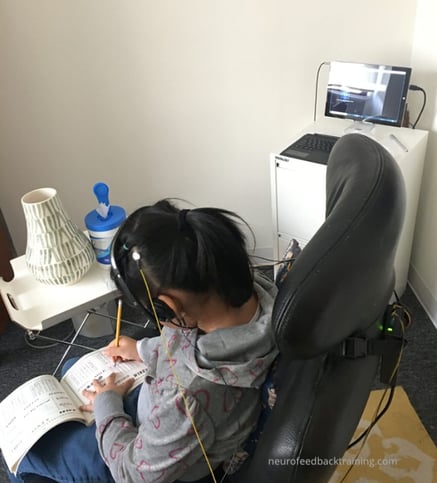 Another way to reset the mental and emotional toll of overuse of social media is to try brain training with neurofeedback. Neurofeedback is a safe and non-invasive tool that builds the brain's resilience and flexibility. The NeurOptimal® neurofeedback system works by alerting the brain to its habitual decisions, which are tracked through measuring the brain's electrical communication.
Another way to reset the mental and emotional toll of overuse of social media is to try brain training with neurofeedback. Neurofeedback is a safe and non-invasive tool that builds the brain's resilience and flexibility. The NeurOptimal® neurofeedback system works by alerting the brain to its habitual decisions, which are tracked through measuring the brain's electrical communication.
This advanced brain training technology - developed in part by NASA-level engineers, works by triggering what is called the orienting response: the brain’s ability to sense change in the environment and take in new information about what is different.
Including neurofeedback during a digital detox helps us build awareness and resets the brain's emotional and mental habits.
When I am working with teenagers, I typically recommend they do neurofeedback before and during their digital detox. I want them to have as much support as possible for interrupting the habits, while providing the support they need for forming new behaviors. With the benefits of calm and focus, neurofeedback helps reach those goals.
Social media usage continues to go up and up. Facebook now has over a billion users worldwide, many of them young people. This means the human need to compare ourselves to others, is increasingly present in developing teen brains. On social media, people tend to project the best version of themselves, even if they feel or act differently offline.
A number of research studies point this out and show that low self-esteem is correlated to time on social media. Social media has been linked to increased feelings of loneliness, anxiety, depression and envy. For more information about some of this research, visit NY Behavioral Health site.
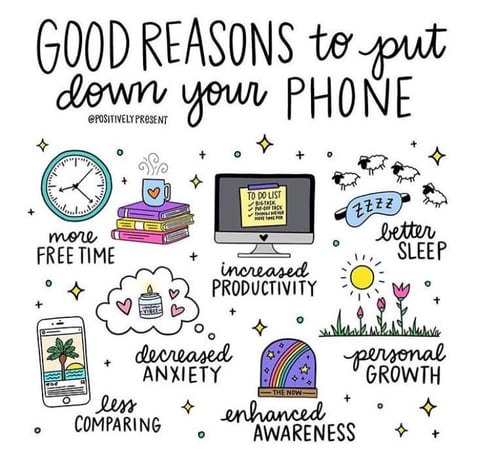
This is an important and personal question. Here are some questions to explore when deciding if you should remove your child's phone at bedtime.
If you answered yes to one or a few of the above questions, then chances are your child's cell phone usage might be causing them distress.
If a child isn't sleeping at night because they're on their phone or because some content they watched on the phone charged them up in someway, it is important to know about that and limit it, if possible. The key here is to ask your teen questions and understand what their experiences are to the best of your ability.
When it comes to smartphone and social media rules for teens and assessing whether a detox would help, use the guidepost of asking yourself (or in concert with your partner) "Why". Why would I create rules, what is the goal? Is the goal better mental health, more family time, fewer distractions? Knowing the why, and discussing the goals with your teen can create a plan that works not just for a short-term detox, but for healthy habits that will last a lifetime.
Natalie Baker has over 25 years of experience as a licensed psychotherapist and has been a NeurOptimal® neurofeedback trainer since 2011. She is the founder of Neurofeedback Training Co., which offers in-person sessions and runs the largest nationwide home rental program for NeurOptimal systems. Natalie also teaches meditation and Buddhist psychology and specializes in working with anxiety, stress, ADHD, and trauma.
Does your teen struggle? Discover the early warning signs of teen stress and learn an action plan to help your teens cope with school, SATs, and...
Teach your child mindfulness and help them develop self-control, self-regulation, and resilience. Discover the evidence-based benefits in our...
Optimize brain function and allow resetting negative habits with NeurOptimal® neurofeedback. Learn five effective brain training tips to manage...
Be the first to know about new blogs